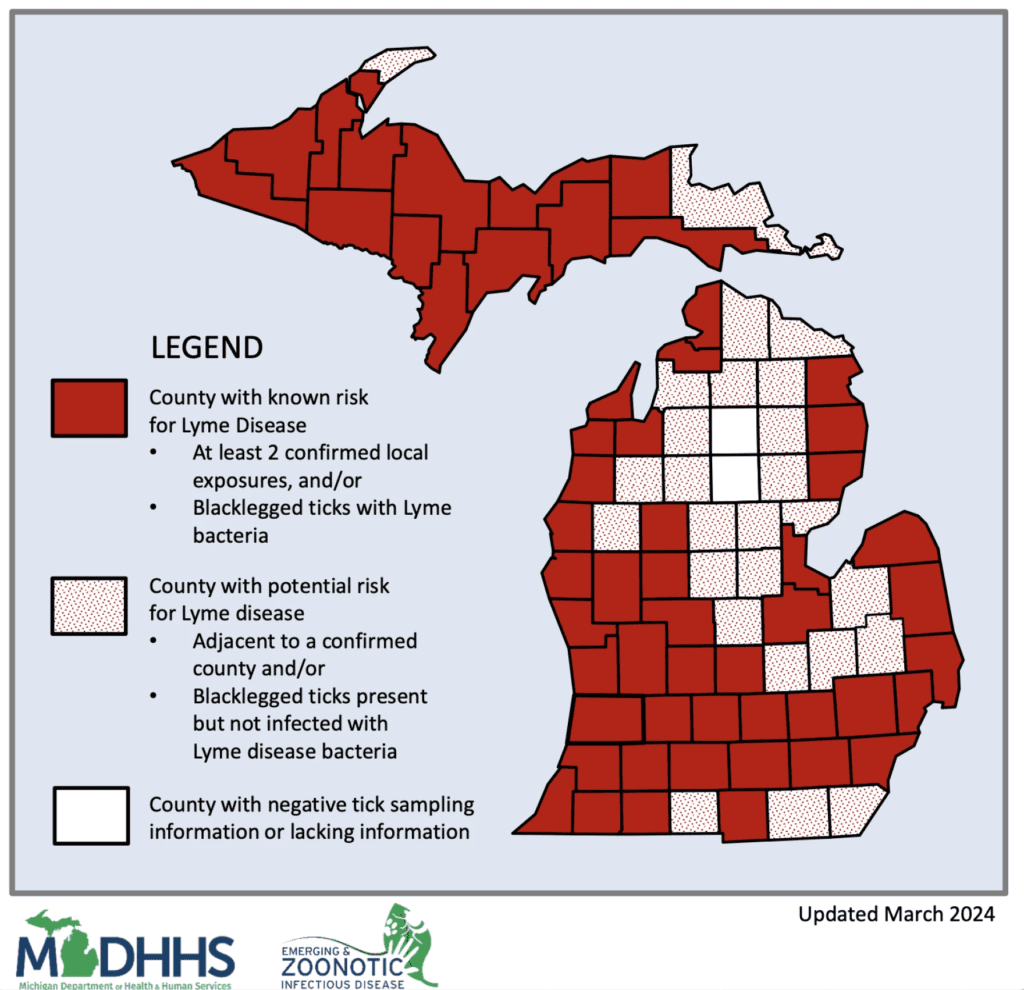Subscribe!
Tick update!

A blacklegged deer tick. This insect is known to carry the microorganism that causes Lyme Disease.
The tick situation in Macomb and Oakland has taken a turn for the worse.
The latest Lyme Disease distribution maps for the state of Michigan show a statewide increase in the prevalence of ticks testing positive for the organism which causes this dreaded chronic infectious disease. Take a look at the difference between the State of Michigan’s 2018 and 2024 maps in the Macomb and Oakland County area (circled below). Patients with tick bites are frequent visitors to Michigan urgent care centers.


As you can see, both Macomb and Oakland Counties are solid red now, indicating at least 2 confirmed local exposures and/or blacklegged (Deer) ticks testing positive for the organism that causes Lyme Disease, known as Borrelia burgdorferi.
How to reduce your Lyme Disease risk
The Number One strategy is to simply avoid ticks. This means that if you (or your children) are outdoors, remember to wear protective clothing, including a hat, long sleeve shirt and long pants when practical — especially in densely-wooded brush. Regardless of what you’re wearing, be sure to examine your person (or your children) for ticks before coming back inside: check the scalp, neck, torso, limbs carefully. Running a brush or comb through your hair will often catch on an embedded tick. A family member can help you to spot ticks in hard to view areas like your back. A mirror can also work. They are usually no bigger than a pencil eraser, although if engorged with blood they can be quite a bit larger. Most ticks can be removed by the patient and do not require an urgent care or emergency visit. Some should be seen by a doctor in order to be evaluated for Lyme Disease risk, which we will discuss below.
How to remove a tick
If you discover a tick fastened to your skin, don’t panic. Avoid digging at or scraping the tick. Never attempt to burn or poison a tick! You will likely do more harm than good. All you need is a common household tweezers and a little patience! Here are the simple steps to take next:
1. Use the tweezers to grasp the bug securely by the head (not the main body). This enables you to remove the pincers without them being separated from the body and remaining in your skin.
2. Using steady, continuous pressure, pull the tick away from your body until your skin “tents” up slightly. Hold this gentle, steady pressure. Do not jerk or yank the tick or it may break off, leaving the pincers in your skin.
3. Keep the steady pull on the tick that maintains tented skin for about 2 minutes. The tick will slowly begin to loosen his pincer grip. Continue the steady pulling until the tick is fully free.
The next two steps will help determine your Lyme Disease risk and your need to see a doctor…
4. After successful removal, put the tick into a jar or other container with some rubbing alcohol. Try to identify the tick using various online tick ID sites (eg: https://mlda.org/prevention/tick-photos/) If the tick is clearly a dog tick, relax. Nothing further needs to be done. That’s because they are not known to carry Lyme Disease.
5. If you’re sure not sure, or you’re positive it’s a deer tick, try to estimate how long it has been embedded in your skin. If it’s been 24 hours or more, then it’s best to be further evaluated by your doctor or at an urgent care center. To improve Tick ID accuracy, bring the tick in with you. If the tick has definitely been embedded for less than 24 hours, the risk and low and nothing further needs to be done.
Tick-borne Lyme Disease is a significant threat, but fortunately, your risk of contracting it remains quite low. Fortunately, those odds can be further reduced by following the basic preventive measures outlined above.
Village Health is open from 8a-8p M-F and 8a-2p Saturday. We can be reached at (586) 752-7256



